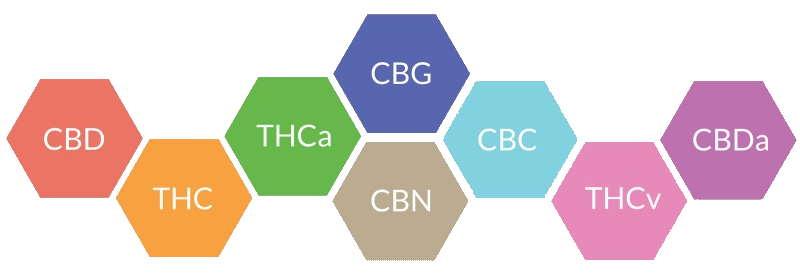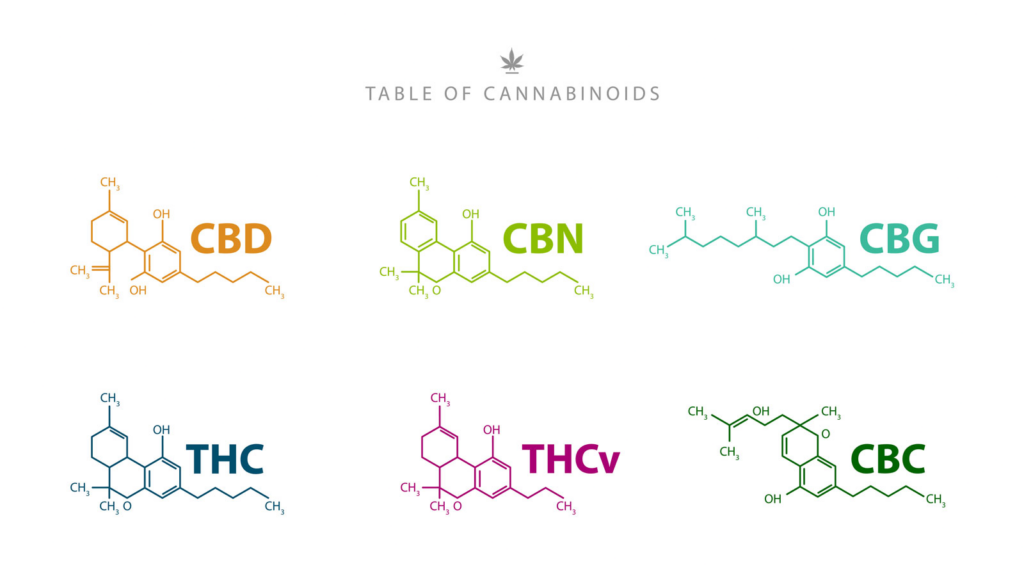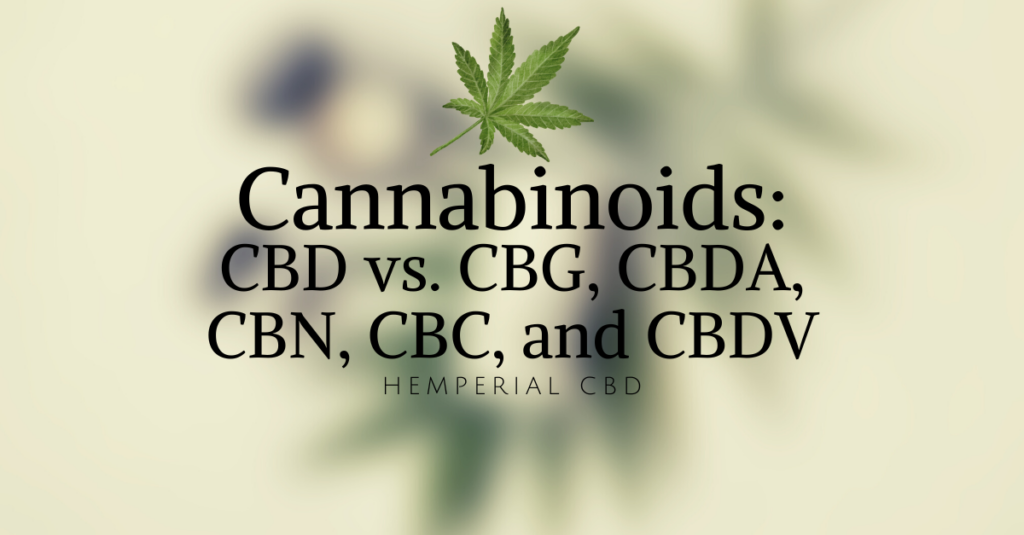You might not be aware that the cannabis industry is about more than simply CBD if you’ve only recently learned about the health advantages of hemp-derived goods that are now on the market. What if we told you there’s more to it then just CBD? What’s the difference between CBD vs. CBG, CBDA, CBN, CBC, and CBDV?
Naturally, one of the most significant cannabinoids in the hemp plant is CBD. Since its discovery, perceptions of cannabis have altered significantly across the globe. The use of CBD for a variety of health issues is supported by a growing amount of scientific research. According to studies, CBD is a good treatment for inflammation, nausea, seizures, anxiety, depression, discomfort, and trouble sleeping without the intoxicating effects of THC.
However, did you realize that the hemp plant contains more cannabinoids than just two? Actually, there are more than 100 substances that resemble CBD. Despite having similar characteristics, each of them has particular advantages and when combined, they have synergistic effects.
In this article, we discuss the differences among the six cannabinoids that have received the most research: CBD, CBDA, CBN, CBG, CBV, and CBDV. We also discuss the unique applications of each cannabinoid.
Before We Start, What Are Cannabinoids?
No one is born a cannabis expert despite the fact that everyone has endocannabinoid systems, which means we are all predisposed to using cannabinoids. All these acronyms we just used can be confusing to someone who is unfamiliar with CBD products.
Therefore, before we delve further into the topic, let’s first clarify one fundamental concept: what are cannabinoids?
Cannabinoids are organic substances that were first identified and isolated by Israeli scientists in the cannabis plant’s resin glands in the 1950s. These substances, which are praised for their numerous therapeutic properties, are what give cannabis its diverse spectrum of medical benefits.
Each chemical has special qualities and advantages. Additionally, they cooperate to speed up the body’s absorption of cannabis. The entourage effect, as this synergy is known among scientists, is what makes full-spectrum solutions preferable to isolate-based extracts.
More cannabinoids are anticipated to be uncovered as scientists learn more about the intricate molecular makeup of cannabis plants, which have already produced more than 110 cannabinoids.
Various Cannabinoid Classes

The following subcategories of cannabinoids are categorized:
- Major cannabinoids: Cannabidiol (CBD) and Tetrahydrocannabinol (THC)
- Minor cannabinoids: Cannabichromene (CBC), Cannabigerol (CBG), Cannabinol (CBN), Cannabinodiol (CBDL)
- Other cannabinoids: Cannabielsoin (CBE), Cannabitriol (CBT), Cannabicyclol (CBL)
The primary regulatory network that is related to other crucial systems in our bodies, the endocannabinoid system, is affected by cannabinoids. These molecules adhere to the cannabinoid receptors found on the cell surface. Different parts of the body have these receptors. We discriminate between CB1 and CB2 cannabinoid receptor types.
The region of the brain that the cannabinoids attach to determines the impact they have. For instance, they can influence memory, cognition, and psychomotor function when they bind to the limbic system. These substances can also change how the brain perceives pain and the pleasure and reward centers.
Major variations between cannabinoids
The degree of their psychoactivity determines the main distinction between the cannabinoids. For instance, due to their chemical makeup, CBD, CBD, and CBG cannot cause intoxication, whereas CBDL, CBN, THC, and other cannabinoids exhibit varying degrees of psychoactivity.
THC and CBD are the two most often used cannabis compounds. Amazingly effective at reducing anxiety, CBD can also counteract THC’s effects on the mind. THC turns into CBN, a less psychoactive substance that lessens the effects of THC’s intoxication, when it comes into contact with oxygen.
seems simple thus far?
We’ll get into the specifics of CBD, CBDA, CBN, CBG, CBC, and CBDV in the following section.
How Do Cannabinoids Get Used by the Body?
Due to the endocannabinoid system, a complicated internal process of cannabis, each person reacts to it differently. All biological processes can be controlled by this significant network of receptors, which is dispersed throughout the body.
Nearly every major organ system, including the brain, spinal cord, and gut, contains cannabinoid receptors. While CB2 receptors are associated with immune system cells, CB1 receptors are most abundant in the brain and central nervous system.
Simply put, the endocannabinoid system aids in the maintenance of a steady and healthy internal environment in our bodies.
The cannabinoid receptors in your body gain the ability to influence many important bodily functions, including memory, appetite, pain, mood, neuroprotection, immunological function, cognitive processes, fertility, body temperature, and more, when cannabinoids are introduced into your system.
The way that particular cannabinoids interact with the endocannabinoid system determines the effects that they have. Below, we’ll examine more closely at this interaction.
What is CBD?
Cannabidiol, the second most important cannabinoid in the cannabis plant, is known by the abbreviation CBD. Unlike THC, the main psychoactive ingredient in marijuana, CBD has no such effects. That makes it safe to use even before going to work or operating a motor vehicle because you can use it for a variety of health benefits without getting high. In order to meet various demands, CBD can be integrated into a variety of products, including oils, CBD gummies, lotions, and CBD capsules.
In addition, CBD has received the most research to far, and its potential uses as a medicine are constantly growing.
According to studies, CBD can assist in the treatment of:
- Daily physical discomfort
- Chronic pain
- Inflammation
- Anxiety and stress-related problems
- Nausea and vomiting
- Seizures and convulsion
- Skin conditions such as acne, eczema, and rashes
Some of these health advantages may already be known to you, but did you realize that living hemp plants contain very little CBD? CBD first appears as its precursor, CBDA, before it is activated.
Why are so many individuals include raw hemp in their diets and what is CBDA?
Find out by continuing to read!
What is CBDA?
Cannabidiolic acid, often known as CBDA, is a cannabinoid that cannabis plants emit in their stems, leaves, and flowers. The acid is taken out of CBDA, activating CBD, via decarboxylation, the process of applying heat to activate particular cannabinoids in cannabis. Due to this, CBDA is regarded as CBD’s forerunner.
Despite having identical chemical makeups and physiological effects, CBDA hasn’t been the focus of as much academic study as CBD. So far, it has been discovered that the endocannabinoid system’s main COX-2 inhibitor is CBDA. The aforementioned discovery prompted research into CBDA’s possible use in treating inflammation. Recent research has also looked into CBDA’s effectiveness in treating cancer and various types of nausea.
Last but not least, CBD and CBDA can be consumed in numerous ways. Since CBDA is found in unprocessed hemp plants, the plant’s juice is frequently used to extract the substance. The juice can be infused into unprocessed extracts like tinctures and live resins, or it can be added to foods and beverages.
What is CBN?
Cannabinol, sometimes known as CBN, is a chemical found in cannabis plants. Scientists first produced and extracted CBN as a byproduct of the breakdown of THC. THC transforms into CBN when it comes into contact with heat or oxygen, or when the cannabis plant begins to wither.
Although CBN is produced from THC, it has significantly less psychoactive potential. It won’t give you the same type of high as THC does.
They are less adaptable than many other cannabinoids in terms of the effects of CBN on the endocannabinoid system. CBN has, however, been the subject of substantial research as a potential sleeping aid. Researchers have shown that CBN is a potent sedative by comparing its effects to those of widely used medications like diazepam. Animal studies have demonstrated that CBD helps lengthen sleep, and subsequent studies indicate that the effects of CBD and THC together may be even more potent.
In addition to its effect on sleep patterns, CBN has also been investigated as a potential stimulant for the development of bone tissue. According to research, it may trigger stem cells that are involved in the development of new bone, making it potentially helpful for conditions that cause bone degeneration.
More research has examined CBN’s analgesic, antibacterial, anti-inflammatory, and anticonvulsant activities. However, CBN-based health supplements are still not generally accessible.
What is CBG?
Cannabigerol, sometimes known as CBG, is a non-psychoactive cannabinoid with a number of intriguing potential medical applications. The forerunner to its more well-known cousins, CBD and THC, is CBG. Similar to CBDA, CBG changes into these substances when exposed to heat and light. The importance of CBG in generating the entourage effects comes from the fact that it can speed up the effects of other cannabinoids.
Most cannabis strains have very little CBG, typically less than 1%. This does not imply, however, that this cannabinoid is less beneficial than the ones indicated above. It can naturally raise dopamine levels by interacting with both CB1 and CB2 receptors, promoting hunger, mood, and sleep. Inhibiting serotonin receptors and altering GABA absorption in the brain are two additional ways that CBG can lessen anxiety and depression.
Additionally, CBG has been noted as particularly beneficial for the following physiological symptoms in the scientific literature:
- Cancer: A recent study found that CBG has anti-cancer properties. It might prevent cancer cells from growing by blocking the receptors that cause them. Researchers have found that giving mice CBG inhibited the growth of colorectal cancer cells, suggesting
- Glaucoma: CBG has been demonstrated to be particularly effective in reducing glaucoma-related intraocular pressure. Researchers attributed the effects to the high concentration of endocannabinoid receptors in the structures of the eye.
- MRSA: When used topically for MRSA patients, who have bacterial strains that are resistant to many classes of antibiotics, a European study found that CBG has antibiotic properties.
Additionally, CBD has been researched as a potential anti-inflammatory treatment for IBD. Additionally, it can increase bladder function, increase hunger, and slow down nerve cell aging.
What is CBC?
Cannabichromene, or CBC, is a cannabinoid that was identified more than 50 years ago. Similar to CBD and THC, CBC is produced when heat or light is used to break down the acid in CBDA.
CBC is not intoxicating, just like other CBD molecules. Even though this cannabinoid is still undergoing research, there are already a number of possible uses that have been identified.
The endocannabinoid system’s vanilloid receptor 1 (TRPV), frequently referred to as the “third cannabinoid receptor,” is where CBC binds most efficiently. Additionally, it interacts with transient receptor potential ankyrin 1 (TRPA1), a receptor that affects how we perceive pain. Accordingly, CBC may be used to treat pain in a manner similar to that of conventional painkillers like NSAIDs, but without the latter’s potentially hazardous side effects.
Particularly when taken with THC, CBC has been demonstrated to be particularly efficient at reducing inflammation in illnesses like osteoarthritis.
Additionally, due to its capacity to inhibit the development of cancer cells, several studies have suggested that CBC may be a useful anti-cancer agent. The anti-inflammatory properties of CBC may also make it beneficial in treating skin outbreaks and acne, even if there aren’t many research in this area. The primary cause of many types of acne, sebaceous gland inflammation, is thought by scientists to be preventable by CBC.
What is CBDV?
Cannabidivarin, often known as CBDV, is the final cannabinoid on our list. Although CBDV and CBD are nearly identical at the molecular level, recent research indicates that CBDV has some extremely special applications that may help those with neurological diseases.
CBDV offers a significant deal of potential as a potential treatment for epilepsy and related neurological diseases, according to preliminary investigations on animal models. It possesses exceptional anticonvulsant and antiepileptic characteristics, and researchers are considering how it can help people who have epilepsy, Parkinson’s disease, post-injury tremors, and other illnesses that might cause seizures.
Not only does CBDV appear to shorten seizure episodes, but it may also have the potential to stop convulsions altogether. A European cannabis business called GW Pharmaceuticals is attempting to patent the use of CBDV to treat uncontrollable types of seizures.
Apart from its strong anticonvulsant effects, CBDV may also help people who are experiencing nausea and vomiting due to chemotherapy side effects. Additionally, the cannabinoid has been investigated as an appetite suppressant and as a potential treatment for multiple sclerosis and Crohn’s disease.
How can I tell which cannabinoid is most effective?
With so many cannabinoids available, there is probably one that can solve almost every issue. It makes sense that after reading about all of these compounds, you might be uncertain about which one will be most effective in your particular circumstance.
Start by figuring out your symptoms if you want to focus your search for the proper cannabinoid. CBD is the most efficient and accessible treatment for many common illnesses, such as anxiety, pain, inflammation, sleep issues, and skin diseases. It comes in a variety of forms, including CBD oils, gummies, pills, and topical applications.
If you’re contemplating utilizing the small cannabinoids discussed in this article as a therapy option for a rare health condition, you should speak with your doctor first. They might have access to important studies on cannabinoid-based extracts that are carried out annually and so be able to give you expert advice.
The highest therapeutic results, according to experts in the field of cannabinoids, can be obtained by integrating all the beneficial components of cannabis into a single product. These goods are referred to as “full-spectrum” extracts and create a special synergy termed as “the entourage effect” by scientists. Minor cannabinoids and terpenes surround the primary active components (CBD and THC) in the plant, enhancing their medicinal effects while reducing any potential negative effects.
These statements have not been evaluated by the Food and Drug Administration. Hemperial CBD products are not intended to prevent, diagnose, treat, or cure any disease or medical condition.
We advise you to conduct your own research on CBD products because the FDA has not issued standards governing the production and labeling of CBD. To acquire a more complete image of the business you wish to buy from, we also urge you to read the lab reports and customer reviews.
FAQ Regarding Cannabinoid Varieties

What distinguishes CBD, CBG, and CBN from one another?
Cannabinoids including CBD, CBN, and CBG are secreted in the resinous sections of the cannabis plant. Their results do, however, slightly vary. Because of their soothing effects, CBD and CBN are excellent for lowering stress and promoting sound sleep. Contrarily, CBD has more of an energizing effect when ingested, which can improve your energy, focus, motivation, and mood stability.
What advantages does CBG offer?
From a stronger metabolism to greater mood improvement and pain control, CBG has several advantages. CBG is also anti-inflammatory.
Can CBD and CBG be used together?
You can indeed combine these two cannabinoids. Given that CBG can be more energizing and CBD is often soothing, the two substances together have better balanced effects on the body and mind. To maintain that balance if CBD makes you sleepy, try taking CBG at the same time.
Can CBG reduce anxiety?
According to research, CBG reduces anxiety by stimulating a variety of endocannabinoid receptors that control how we react to stress.
The Differences Between CBD, CBG, CBC, CBN, and CBDV: Final Notes
Cannabis plants are quite sophisticated. Their stalks, leaves, and flowers contain more than 400 different substances, of which more than 100 have been identified as cannabinoids with possible medical benefits.
Although CBD and THC have received the majority of attention in contemporary medicine to date, researchers are now focusing their attention on additional useful chemicals like terpenes and minor cannabinoids that are present in hemp.
The cannabinoids discussed in this article each have a special set of health advantages. Full-spectrum extracts are preferred to products based on single molecules because they help the body process the main cannabinoids more effectively when taken together.
Unlocking the potential of different cannabinoids and figuring out how they might collaborate to benefit your health opens up chances for individualized supplementation based on all-natural ingredients.
